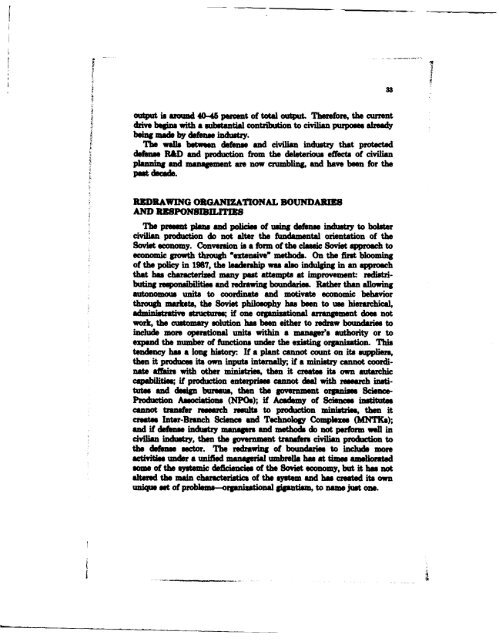Perestroika and Change in Soviet Weapons ... - The Black Vault
Perestroika and Change in Soviet Weapons ... - The Black Vault
Perestroika and Change in Soviet Weapons ... - The Black Vault
Create successful ePaper yourself
Turn your PDF publications into a flip-book with our unique Google optimized e-Paper software.
i<br />
I<br />
83<br />
output is around 40-45 percent of total outpuL <strong>The</strong>refore, the current<br />
drive beg<strong>in</strong>s with a substantial contribution to civilian purposes already<br />
be<strong>in</strong>g made by defense <strong>in</strong>dustry.<br />
<strong>The</strong> walls between defense <strong>and</strong> civilian <strong>in</strong>dustry that protected<br />
dfense R&D <strong>and</strong> production from the deleterious effects of civilian<br />
plann<strong>in</strong>g <strong>and</strong> management are now crumbl<strong>in</strong>g, <strong>and</strong> have been for the<br />
past decade.<br />
REDRAWING ORGANIZATIONAL BOUNDARIES<br />
AND RESPONSIErHTIES<br />
<strong>The</strong> present plane <strong>and</strong> policies of us<strong>in</strong>g defense <strong>in</strong>dustry to bolster<br />
civilian production do not alter the fundamental orientation of the<br />
<strong>Soviet</strong> economy. Conversion is a form of the classic <strong>Soviet</strong> approach to<br />
economic growth through *extensive methods. On the fiet bloom<strong>in</strong>g<br />
of the policy <strong>in</strong> 1987, the leadership was also <strong>in</strong>dulg<strong>in</strong>g <strong>in</strong> an approach<br />
that has characterized many past attempts at improvent: redistribut<strong>in</strong>g<br />
spoibilit <strong>and</strong> redraw<strong>in</strong>g boundaries. Rather than allow<strong>in</strong>g<br />
autonomous units to coord<strong>in</strong>ate <strong>and</strong> motivate economic behavior<br />
through markets, the <strong>Soviet</strong> philosophy has been to use hierarchical,<br />
adm<strong>in</strong>istrative structures; if one organizational e nt does not<br />
work, the customary solution has been either to redraw boundaries to<br />
<strong>in</strong>clude more operational units with<strong>in</strong> a manager's authority or to<br />
exp<strong>and</strong> the number of functions under the exist<strong>in</strong>g organization. This<br />
tendency has a long histor. If a plant cannot count on its suppliers,<br />
then it produces its own <strong>in</strong>puts <strong>in</strong>ternally, if a m<strong>in</strong>istry cannot coord<strong>in</strong>ate<br />
affairs with other m<strong>in</strong>istries, then it creates its own autarchic<br />
capabilities; if production enterprises cannot deal with research <strong>in</strong>titute<br />
<strong>and</strong> design bureaus, than the government orgnizes, Science-<br />
Production Associations (NPOs); if Amdemy of Sciences <strong>in</strong>stitutes<br />
cannot transfer research results to production m<strong>in</strong>istries, then it<br />
creats Inter-Branch Science <strong>and</strong> Technoloa Complexes (MNTKs);<br />
<strong>and</strong> if defense <strong>in</strong>dustry managers <strong>and</strong> methods do not perform wol <strong>in</strong><br />
civilian <strong>in</strong>dustry, then the government trimsfe civilian production to<br />
the defense sector. <strong>The</strong> redraw<strong>in</strong>g of boundaries to <strong>in</strong>chle mor<br />
activities under a unified managerial umbrella has at tiom ameliorsted<br />
some of the systemic deficiencies of the <strong>Soviet</strong> economy, but it has not<br />
alterd the ma<strong>in</strong> characteristics of the system <strong>and</strong> has created its own<br />
unique set of probUms-orgnixational gigantiam, to name just one.
















